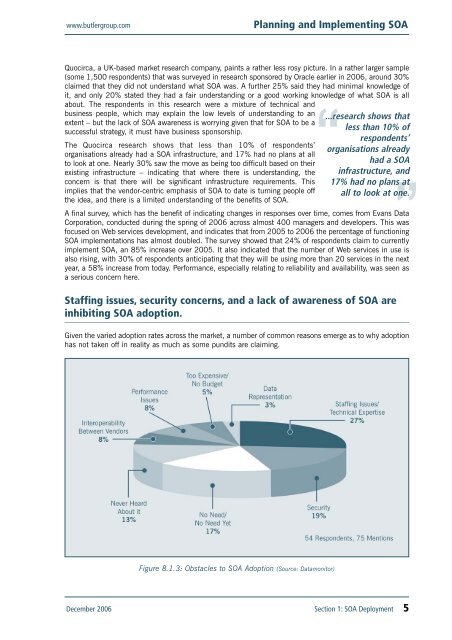Planning_and_Impleme.. - didier beck weblog
Planning_and_Impleme.. - didier beck weblog
Planning_and_Impleme.. - didier beck weblog
You also want an ePaper? Increase the reach of your titles
YUMPU automatically turns print PDFs into web optimized ePapers that Google loves.
www.butlergroup.com<br />
<strong>Planning</strong> <strong>and</strong> <strong>Impleme</strong>nting SOA<br />
Quocirca, a UK-based market research company, paints a rather less rosy picture. In a rather larger sample<br />
(some 1,500 respondents) that was surveyed in research sponsored by Oracle earlier in 2006, around 30%<br />
claimed that they did not underst<strong>and</strong> what SOA was. A further 25% said they had minimal knowledge of<br />
it, <strong>and</strong> only 20% stated they had a fair underst<strong>and</strong>ing or a good working knowledge of what SOA is all<br />
about. The respondents in this research were a mixture of technical <strong>and</strong><br />
business people, which may explain the low levels of underst<strong>and</strong>ing to an<br />
extent – but the lack of SOA awareness is worrying given that for SOA to be a<br />
successful strategy, it must have business sponsorship.<br />
The Quocirca research shows that less than 10% of respondents’<br />
organisations already had a SOA infrastructure, <strong>and</strong> 17% had no plans at all<br />
to look at one. Nearly 30% saw the move as being too difficult based on their<br />
existing infrastructure – indicating that where there is underst<strong>and</strong>ing, the<br />
concern is that there will be significant infrastructure requirements. This<br />
implies that the vendor-centric emphasis of SOA to date is turning people off<br />
the idea, <strong>and</strong> there is a limited underst<strong>and</strong>ing of the benefits of SOA.<br />
...research shows that<br />
less than 10% of<br />
respondents’<br />
organisations already<br />
had a SOA<br />
infrastructure, <strong>and</strong><br />
17% had no plans at<br />
all to look at one.<br />
A final survey, which has the benefit of indicating changes in responses over time, comes from Evans Data<br />
Corporation, conducted during the spring of 2006 across almost 400 managers <strong>and</strong> developers. This was<br />
focused on Web services development, <strong>and</strong> indicates that from 2005 to 2006 the percentage of functioning<br />
SOA implementations has almost doubled. The survey showed that 24% of respondents claim to currently<br />
implement SOA, an 85% increase over 2005. It also indicated that the number of Web services in use is<br />
also rising, with 30% of respondents anticipating that they will be using more than 20 services in the next<br />
year, a 58% increase from today. Performance, especially relating to reliability <strong>and</strong> availability, was seen as<br />
a serious concern here.<br />
Staffing issues, security concerns, <strong>and</strong> a lack of awareness of SOA are<br />
inhibiting SOA adoption.<br />
Given the varied adoption rates across the market, a number of common reasons emerge as to why adoption<br />
has not taken off in reality as much as some pundits are claiming.<br />
Figure 8.1.3: Obstacles to SOA Adoption (Source: Datamonitor)<br />
December 2006 Section 1: SOA Deployment 5





